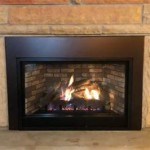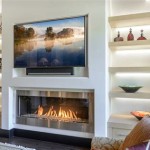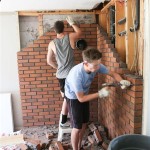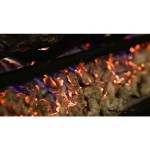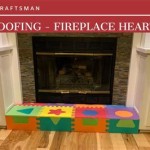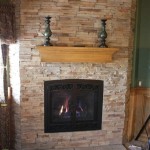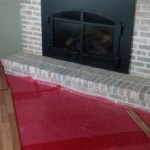Floating Shelf: An Alternative to the Traditional Fireplace Mantel
The fireplace, traditionally a focal point in a home, often features a mantelpiece. This architectural element serves both a decorative and functional purpose, providing a surface for displaying objects, artwork, and seasonal decorations. While traditional mantels remain popular, floating shelves have emerged as a contemporary alternative, offering a minimalist aesthetic and versatile design options. This article explores the benefits, considerations, and installation process of using a floating shelf as a fireplace mantel.
Floating shelves, characterized by their seamless integration with the wall and absence of visible brackets, present a clean and modern appearance. This design choice allows the shelf to visually "float," creating an illusion of weightlessness. This aesthetic can be particularly appealing in homes with contemporary or minimalist design schemes where a bulky traditional mantel might appear out of place. The inherent simplicity of a floating shelf draws attention to the items displayed on it, as opposed to the mantel itself.
One of the most significant advantages of using a floating shelf as a fireplace mantel is its adaptability. Unlike traditional mantels which are often fixed in size and style, floating shelves can be customized to specific dimensions and finishes. This flexibility allows homeowners to perfectly tailor the shelf to the dimensions of the fireplace and the overall room design. Selecting materials such as wood, metal, or even concrete can further enhance the aesthetic impact and complement the surrounding décor.
The installation of a floating shelf as a fireplace mantel requires careful planning and execution to ensure both structural integrity and adherence to fire safety regulations. The shelf must be capable of supporting the weight of the items placed upon it, and the materials used must be fire-resistant or appropriately shielded from the heat of the fireplace. Ignoring these considerations can lead to a compromised shelf and potentially hazardous situation.
Key Point 1: Aesthetic Appeal and Design Versatility
The aesthetic appeal of a floating shelf lies in its understated elegance. Its minimalist design allows it to seamlessly integrate into various architectural styles, from modern to transitional. The clean lines and lack of visible supports contribute to a sense of spaciousness and visual clarity. This is particularly advantageous in smaller rooms where a bulky mantel could overwhelm the space. The absence of ornate details allows the focus to remain on the fire or the displayed items.
Furthermore, the design versatility of floating shelves allows for a high degree of personalization. Homeowners can choose from a wide range of materials, finishes, and sizes to create a mantel that perfectly complements their existing décor. Options include solid wood shelves with natural finishes, painted shelves in a variety of colors, and even shelves constructed from reclaimed wood for a rustic aesthetic. The edge profile of the shelf can also be customized, ranging from a simple square edge to a more decorative rounded or beveled edge.
The placement of the floating shelf can also be strategically chosen to enhance the overall design. It can be positioned directly above the fireplace opening, creating a traditional mantel effect, or it can be offset to one side for a more asymmetrical and modern look. Multiple floating shelves can also be installed at varying heights to create a layered display area. This versatility allows homeowners to experiment with different arrangements and create a unique focal point in their living space.
Beyond its aesthetic considerations, the minimalist nature of a floating shelf can also contribute to a sense of tranquility and calm. In contrast to traditional mantels which are often adorned with elaborate carvings or decorative elements, a floating shelf offers a clean and uncluttered surface. This can be particularly appealing in homes where the overall design philosophy emphasizes simplicity and functionality.
Key Point 2: Installation Considerations and Safety Precautions
Installing a floating shelf as a fireplace mantel requires careful attention to detail and a thorough understanding of structural principles. The primary challenge lies in ensuring that the shelf is securely anchored to the wall and capable of supporting the weight of the items placed upon it. This is typically achieved through the use of hidden brackets or internal support systems that are concealed within the shelf itself.
The type of wall construction will significantly impact the installation process. For drywall walls, it is crucial to locate the wall studs and anchor the shelf brackets directly to them. Using drywall anchors alone is generally insufficient, as they may not be able to support the weight of the shelf and its contents. In cases where the desired shelf location does not align with the wall studs, it may be necessary to install a horizontal ledger board to which the shelf brackets can be attached. This ledger board should be securely fastened to multiple wall studs to distribute the weight evenly.
For masonry walls, such as brick or concrete, specialized anchors will be required. These anchors must be designed to withstand the weight and shear forces associated with a loaded shelf. It is essential to follow the manufacturer's instructions carefully when installing these anchors to ensure a secure and reliable connection.
In addition to structural considerations, fire safety is paramount when installing a floating shelf above a fireplace. The shelf should be positioned at a safe distance from the fireplace opening to prevent it from overheating or catching fire. This distance will vary depending on the type of fireplace and the materials used in the shelf construction. It is advisable to consult local building codes and regulations to determine the minimum safe distance. Using non-combustible materials or applying a fire-retardant coating to the shelf can further enhance fire safety.
It is also important to consider the potential for creosote buildup in the area above the fireplace. Creosote is a highly flammable substance that can accumulate in the chimney and on surrounding surfaces. Regular chimney inspections and cleanings are essential to prevent creosote buildup and reduce the risk of a chimney fire. Ensuring proper ventilation above the fireplace can also help to minimize creosote accumulation.
Key Point 3: Material Selection and Weight Capacity
The choice of materials for a floating shelf fireplace mantel is critical for both aesthetic and functional reasons. The material selected will influence the overall appearance of the mantel and its ability to withstand the heat and weight associated with its location above a fireplace. Common material options include wood, metal, and concrete, each offering unique characteristics and advantages.
Wood is a popular choice for fireplace mantels due to its natural warmth, versatility, and availability in a wide range of species and finishes. Solid wood shelves offer a classic and timeless aesthetic, while engineered wood options, such as plywood or MDF, can provide greater stability and resistance to warping. When using wood near a fireplace, it is essential to select a species that is naturally fire-resistant or to apply a fire-retardant coating to the surface. It is also important to protect the wood from excessive heat and moisture, which can cause it to crack or distort.
Metal is another popular option for floating shelf mantels, offering a sleek and modern aesthetic. Steel, stainless steel, and aluminum are all commonly used metals, each with its own unique properties. Metal shelves are typically more durable and heat-resistant than wood shelves, making them a suitable choice for fireplaces that generate significant heat. However, metal shelves can also become hot to the touch, so it is important to exercise caution when handling them.
Concrete is a more unconventional material choice for floating shelf mantels, but it can offer a unique and industrial aesthetic. Concrete shelves are typically very heavy and require specialized installation techniques to ensure that they are securely anchored to the wall. However, concrete is also highly durable and fire-resistant, making it a long-lasting and safe option for fireplace mantels. Concrete shelves can be cast in a variety of shapes and sizes, allowing for a high degree of customization.
Regardless of the material selected, it is crucial to calculate the weight capacity of the shelf and ensure that it is adequate to support the items that will be placed upon it. The weight capacity will depend on the type of material used, the thickness of the shelf, and the spacing of the support brackets. It is advisable to consult with a structural engineer or a qualified contractor to determine the appropriate weight capacity for a given shelf design. Overloading the shelf can lead to structural failure and potentially dangerous consequences. Before placing items on the shelf, carefully assess their weight and distribute them evenly across the surface.

Floating Fireplace Mantel 48 72 Wood Wall Shelf

Floating Shelf Mantel Fireplace Shabby Coastal Farmhouse Decor

Glass Floating Shelf Fireplace Mantel Mantle Beam Wall Shelves

Collection Of Premium Wood Fireplace Mantels Dogberry

Fireplace Mantle Mantel Beam Floating Shelf Rustic Wooden Wood Shelving Farmhouse Decor Modern

Matte Distressed Floating Shelf Mantel Fireplace Mantels

Chapel White Floating Mantel Shelf Fireplace Built Ins In Around Living Room Decor

Barton 60 In W Floating Vintage Wood Fireplace Mantel Cap Wall Shelf Beam Easy Mount Ash 95156 The Home Depot

Mantels Direct Wallace 36 Inch Floating Wood Fireplace Mantel Shelf In Smoke Gray Com

Modern Floating Mantel Shelf Industrial Mantle Contemporary
Related Posts

